Numerical Study on Dynamical Structures and the Destratification of Vertical Turbulent Jets in Stratified Environment
Abstract
:1. Introduction
2. Governing Equations and Numerical Methods
2.1. Model Description
2.2. Governing Equations
2.3. Numerical Methods and Boundary Conditions
2.4. Dimensionless Description
3. Model Validation
3.1. Mesh Refinement Study
3.2. Validation for the Turbulent Jet in a Unstratified Fluid
3.3. Validation of the Jet in a Stratified Fluid
4. Results
4.1. The Process of Impingement
4.2. Generation of Coherent Structures.
4.3. Destratification of Jets
5. Discussions
5.1. Quantitative Analysis of Hydraulic Properties of Jets Around the Pycnocline
5.2. Quantitative Analysis of the Destratification of Jets
6. Conclusions
- 1.
- The TFD method on inlet boundary of jets is developed to simulate the 3D turbulent jet, and the results of vertical velocity decay and horizontal velocity distribution are in good agreements with experimental data.
- 2.
- In terms of the degree of jets’ breaking up and the turbulent kinetic energy of the cases in this study, the intensity of the interaction between the jet and the pycnocline can be divided into four classes: No turbulence, weak turbulence, intermediate and intense turbulence.
- 3.
- According to the flow field, it can be concluded that the jet can’t penetrate through the pycnocline completely in the range of 1.11 < Frp < 4.77. One part penetrates through the pycnocline, and falls back to the pycnocline again. The other part is blocked by the pycnocline. As a result, vortices with opposite directions are formed in pair on both sides of the pycnocline.
- 4.
- Frp = 3 is a threshold value of the interaction between jets and the pycnocline. When Frp > 3, the interaction becomes intensely. Hence, the jet affects a wider range under the influence of the strong turbulence, and the momentum of the jet is dissipated more efficiently, with a greater destratification effect of jets. In addition, the fitting formula of the radial momentum flux dissipation rate is established through dimensionless analysis.
- 5.
- It is found that the destratification of the jet is mainly affected by the velocity of the internal waves produced by the jet. Regardless of the value of initial pycnocline thickness or Frp, the pycnocline thickness reaches the critical value at T = 1.4 with the influence of the first internal wave. When T > 1.4, the increasing rate apparently slows down and the pycnocline thickness increases linearly in all cases due to the vorticity in the pycnocline becomes small obviously after the thickness of the pycnocline reaches the critical value.
Author Contributions
Funding
Conflicts of Interest
References
- Jirka, G.; Lee, J. Waste disposal in the ocean. In Water Quality and Its Control; Hino, M., Ed.; Balkema: Rotterdam, The Netherlands, 1994; Volume 5, pp. 193–242. [Google Scholar]
- Camilli, R.; Reddy, C.M.; Yoerger, D.R. Tracking hydrocarbon plume transport and biodegradation at deepwater horizon. Science 2010, 330, 201–204. [Google Scholar] [CrossRef]
- Ahmad, N.; Suzuki, T. Study of dilution, height, and lateral spread of vertical dense jets in marine shallow water. Water Sci. Technol. 2016, 73, 2986–2997. [Google Scholar] [CrossRef] [PubMed]
- Zordan, J.; Juez, C.; Schleiss, A.J.; Franca, M.J. Entrainment, transport and deposition of sediment by saline gravity currents. Adv. Water Resour. 2018, 115, 17–32. [Google Scholar] [CrossRef]
- Schleiss, A.J.; Franca, M.J.; Juez, C.; Cesare, G.D. Reservoir sedimentation. J. Hydraul. Res. 2016, 1–20. [Google Scholar] [CrossRef]
- Li, Y.; Huang, T.L.; Tan, X.L.; Zhou, Z.Z.; Ma, W.X. Destratification and oxygenation efficiency of a water-lifting aerator system in a deep reservoir: Implications for optimal operation. J. Environ. Sci. 2018, 73, 13–23. [Google Scholar] [CrossRef] [PubMed]
- Stephens, R.; Jörg, I. Reservoir destratification via mechanical mixers. J. Hydraul. Eng. 1993, 119, 438–457. [Google Scholar] [CrossRef]
- Fast, A.W. Effects of artificial destratification on primary production and Zoobenthos of El Capitan Reservoir California. Water Resour. Res. 1973, 9, 607–623. [Google Scholar] [CrossRef]
- Steinberg, C. Effects of artificial destratification on the phytoplankton populations in a small lake. Freshw. Biol. 1983, 5, 855–864. [Google Scholar] [CrossRef]
- Hamilton, D.P.; Chan, T.; Robb, M.S.; Robb, M.S.; Pattiaratchi, C.B.; Herzfeld, M. The hydrology of the upper Swan River Estuary with focus on an artificial destratification trial. Hydrol. Process. 2001, 15, 2465–2480. [Google Scholar] [CrossRef]
- Schladow, S.G. Lake destratification by bubble-plume systems: Design methodology. J. Hydraul. Eng. 1993, 119, 350–368. [Google Scholar] [CrossRef]
- Hill, D.F.; Vergara, A.M.; Parra, E.J. Destratification by mechanical mixers: Mixing efficiency and flow scaling. J. Hydraul. Eng. 2008, 134, 1772–1777. [Google Scholar] [CrossRef] [Green Version]
- Camassa, R.; Lin, Z.; Mclaughlin, R.M.; Mertens, K.; Tzou, C.; Walsh, J.; White, B. Optimal mixing of buoyant jets and plumes in stratified fluids: Theory and experiments. J. Fluid Mech. 2016, 790, 71–103. [Google Scholar] [CrossRef] [Green Version]
- Turner, J.S. Jets and plumes with negative or reversing buoyancy. J. Fluid Mech. 1966, 26, 779–792. [Google Scholar] [CrossRef]
- Burridge, H.C.; Hunt, G.R. The rise heights of low- and high-Froude-number turbulent axisymmetric fountains. J. Fluid Mech. 2012, 691, 392–416. [Google Scholar] [CrossRef]
- Burridge, H.C.; Hunt, G.R. The rhythm of fountains: The length and time scales of rise height fluctuations at low and high Froude numbers. J. Fluid Mech. 2013, 728, 91–119. [Google Scholar] [CrossRef]
- Ezhova, E.V.; Cenedese, C.; Brandt, L. Interaction between a vertical turbulent jet and a thermocline. J. Phys. Oceanogr. 2016, 46, 3415–3437. [Google Scholar] [CrossRef]
- Druzhinin, O.A.; Troitskaya, Y.I. Internal wave generation by a fountain in a stratified fluid. Fluid Dyn. 2010, 45, 474–484. [Google Scholar] [CrossRef]
- Ezhova, E.V.; Sergeev, D.A.; Soustova, I.A. On the structure of internal waves excited by buoyant plumes in stratified fluid. Bull. Russ. Acad. Sci. Phys. 2008, 72, 1701–1704. [Google Scholar] [CrossRef]
- Ezhova, E.V.; Sergeev, D.A.; Kandaurov, A.A. Nonsteady dynamics of turbulent axisymmetric jets in stratified fluid: Part 1. Experimental study. Izv. Atmos. Ocean. Phys. 2012, 48, 409–417. [Google Scholar] [CrossRef]
- Ezhova, E.V.; Troitskaya, Y.I. Nonstationary dynamics of turbulent axisymmetric jets in a stratified fluid: Part 2. Mechanism of excitation of axisymmetric oscillations in a submerged jet. Izv. Atmos. Ocean. Phys. 2012, 48, 528–537. [Google Scholar] [CrossRef]
- Cotel, A.J.; Gjestvang, J.A.; Ramkhelawan, N.N. Laboratory experiments of a jet impinging on a stratified interface. Exp. Fluids 1997, 23, 155–160. [Google Scholar] [CrossRef]
- Mcdougall Trevor, J. Bubble plumes in stratified environments. J. Fluid Mech. 1978, 85, 655–672. [Google Scholar] [CrossRef]
- Kim, S.H.; Kim, J.Y.; Park, H. Effects of bubble size and diffusing area on destratification efficiency in bubble plumes of two-layer stratification. J. Hydraul. Eng. 2010, 136, 106–115. [Google Scholar] [CrossRef] [Green Version]
- Neto, I.E.L.; Cardoso, S.S.S.; Woods, A.W. On mixing a density interface by a bubble plume. J. Fluid Mech. 2016, 802, R3. [Google Scholar] [CrossRef]
- Chen, Y.P.; Li, C.W.; Zhang, C.K. Numerical study of a round buoyant jet under the effect of JONSWAP random waves. China Ocean. Eng. 2012, 26, 235–250. [Google Scholar] [CrossRef]
- Ansong, J.K.; Kyba, P.J.; Sutherland, B.R. Fountains impinging on a density interface. J. Fluid Mech. 2008, 595, 115–139. [Google Scholar] [CrossRef] [Green Version]
- Zhu, H.; Wang, L.L.; Tang, H.W. Large-eddy simulation of suspended sediment transport in turbulent channel flow. J. Hydrodyn. 2013, 1, 48–55. [Google Scholar] [CrossRef]
- Lin, P.; Chi-Wai, L. A σ-coordinate three dimensional numerical model for surface wave propagation. Int. J. Numer. Methods Fluids 2002, 38, 1045–1068. [Google Scholar] [CrossRef]
- Park, J.C.; Kim, M.H.; Miyata, H. Fully non-linear free-surface simulations by a 3D viscous numerical wave tank. Int. J. Numer. Methods Fluids 2015, 29, 685–703. [Google Scholar] [CrossRef]
- Menow, S.; Rizk, M. Large-eddy simulations of forced three-dimensional impinging jets. Int. J. Numer. Methods Fluids 1996, 7, 275–289. [Google Scholar] [CrossRef]
- Zhou, X.; Luo, K.H.; Williams, J.J.R. Large-eddy simulation of a turbulent forced plume. Eur. J. Mech. B/Fluids 2001, 20, 233–254. [Google Scholar] [CrossRef]
- Jun, L.; Hong-Wu, T.; Ling-Ling, W. A novel dynamic coherent eddy model and its application to LES of a turbulent jet with free surface. Sci. China Phys. Mech. Astron. 2010, 53, 1671–1680. [Google Scholar]
- Xu, Z.; Chen, Y.; Zhang, C. Experimental study on the turbulent jet in regular and random waves. Adv. Water Sci. 2013, 24, 715–721. (In Chinese) [Google Scholar]
- Liu, C.Q.; Wang, Y.Q.; Yang, Y.; Duan, Z.W. New omega vortex identification method. Sci. China Phys. Mech. Astron. 2016, 59, 684711. [Google Scholar] [CrossRef]
- Lin, F.; Chen, X.; Yao, H. Evaluating the use of Nash-Sutcliffe efficiency coefficient in goodness-of-fit measures for daily runoff simulation with SWAT. J. Hydrol. Eng. 2017, 22, 1–9. [Google Scholar] [CrossRef]

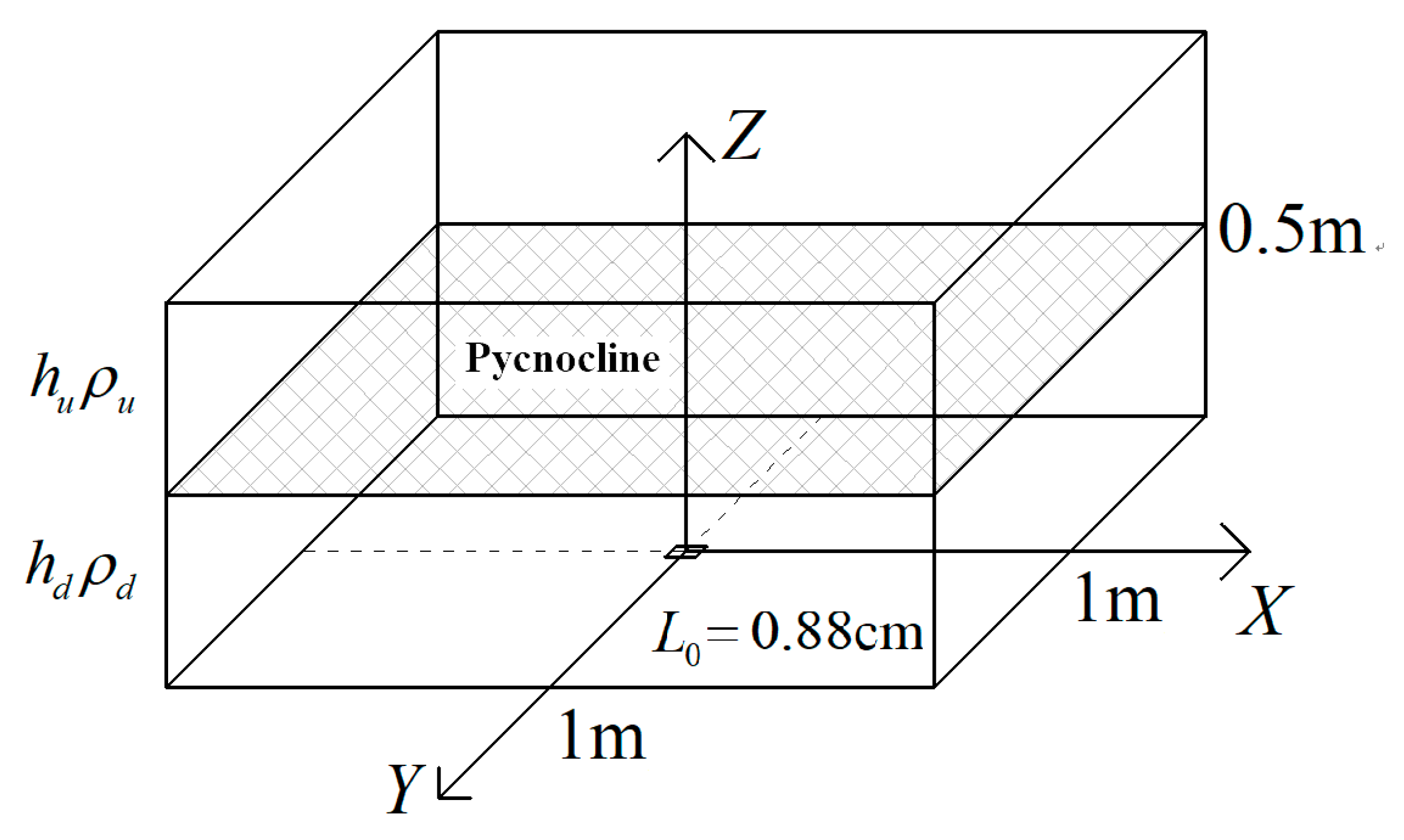
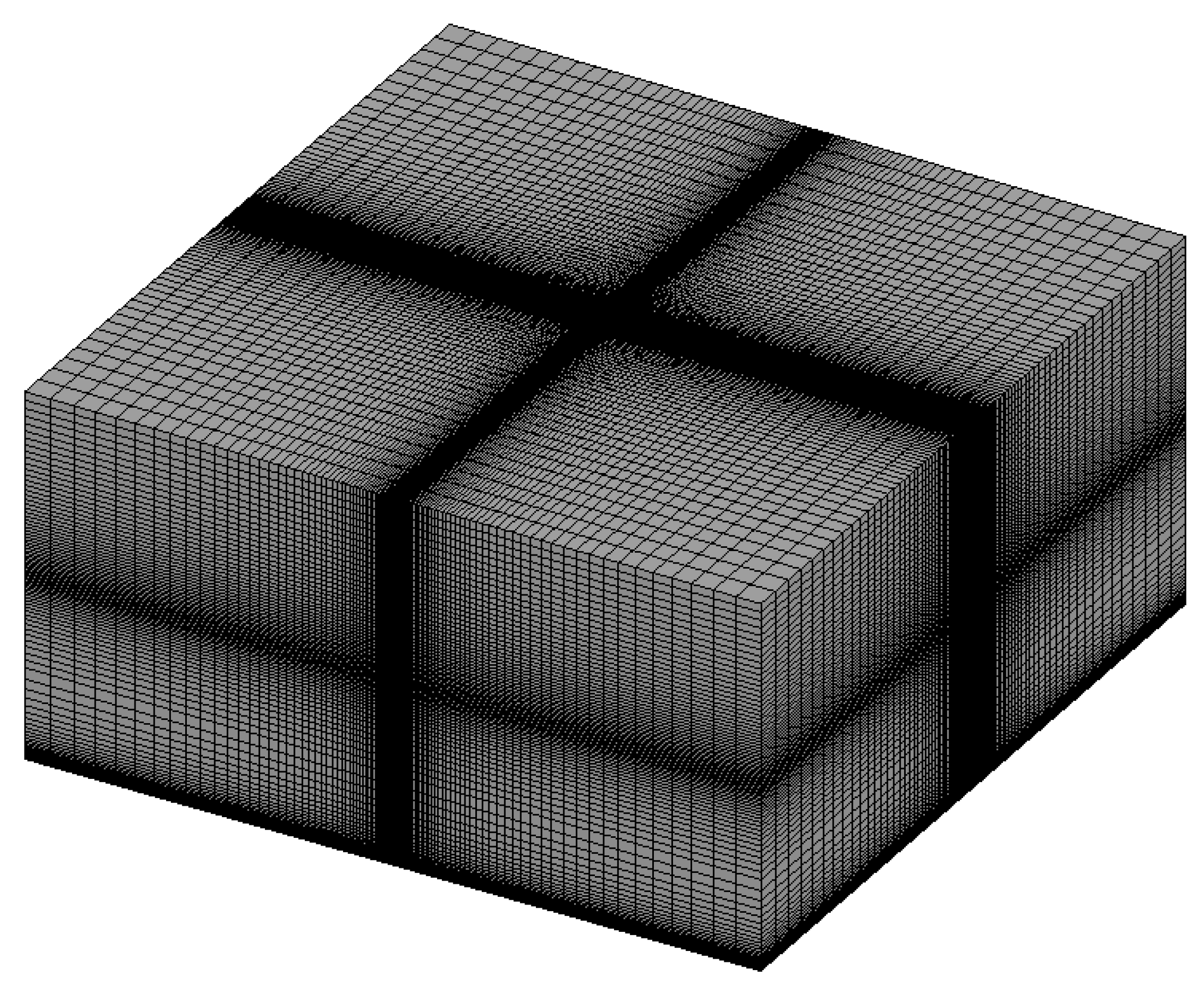
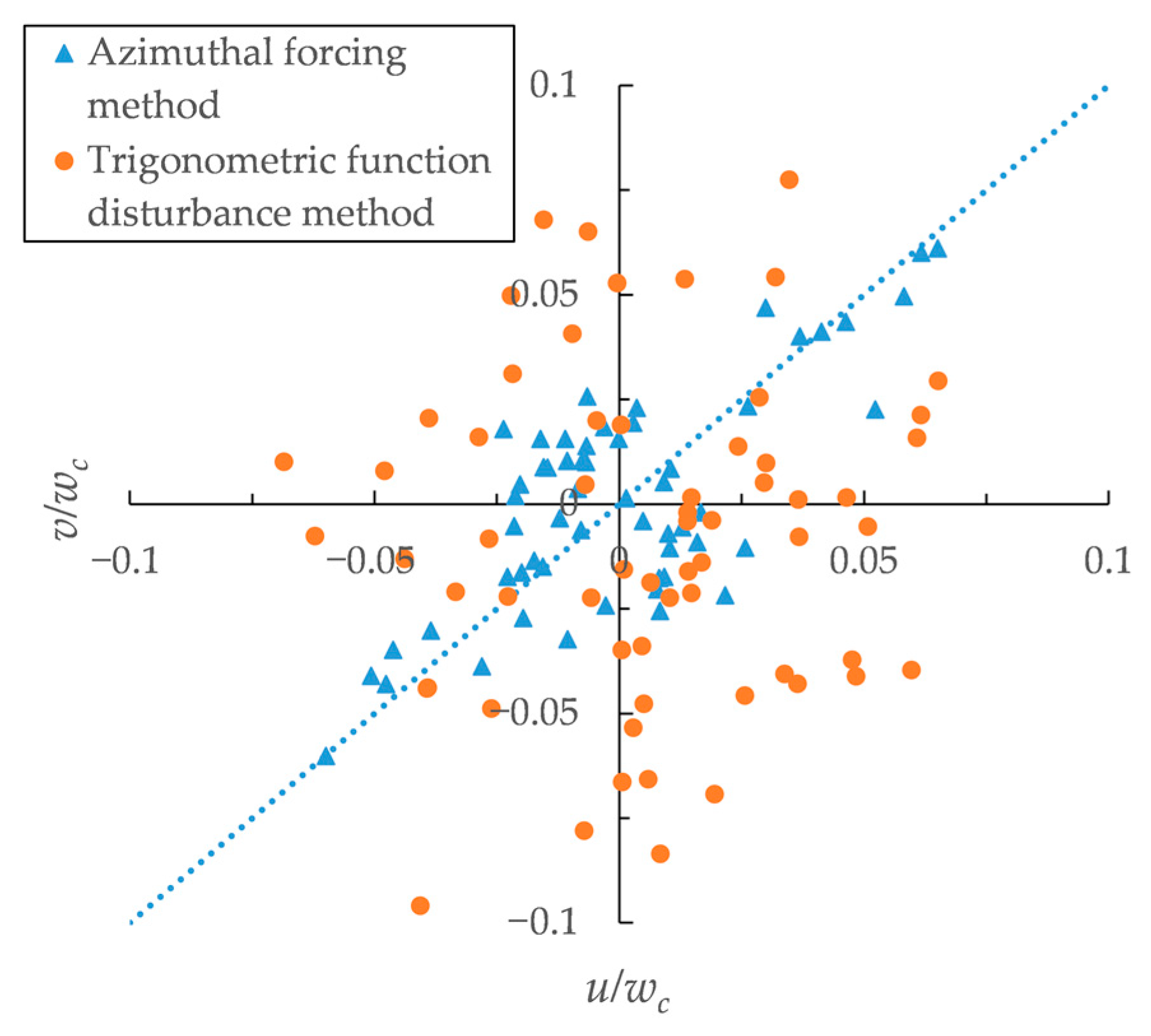
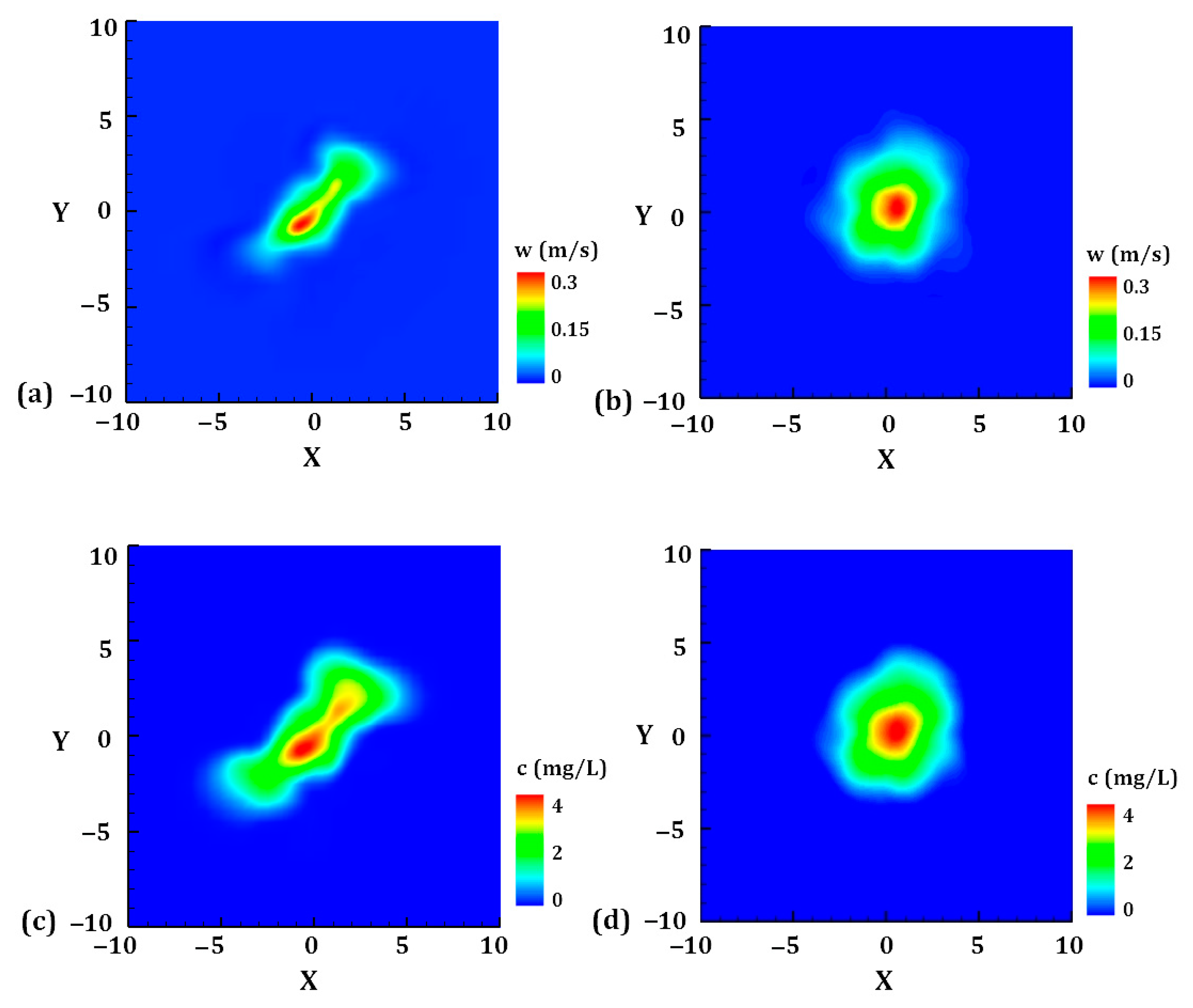
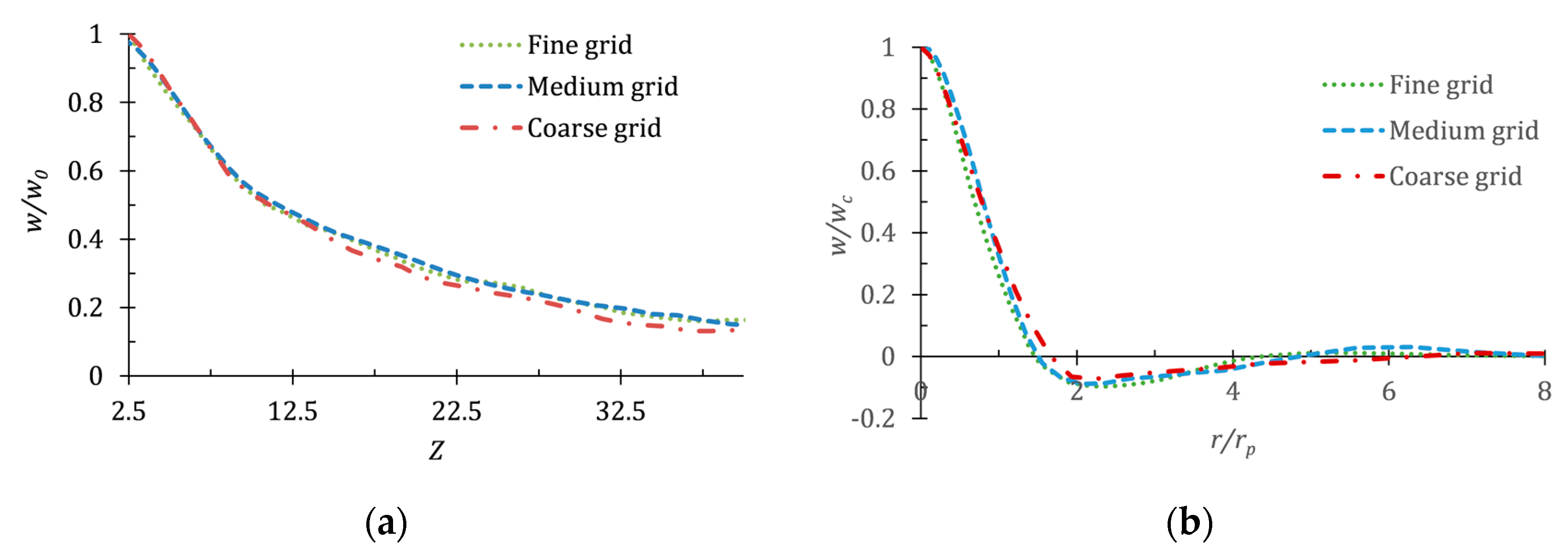
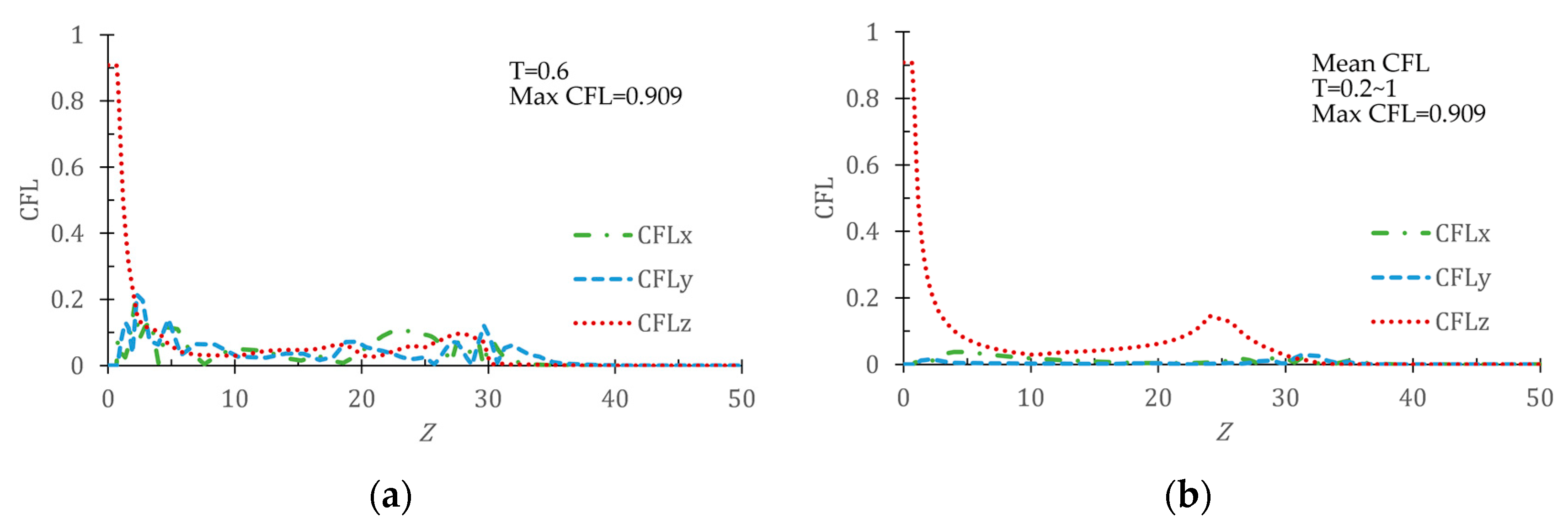
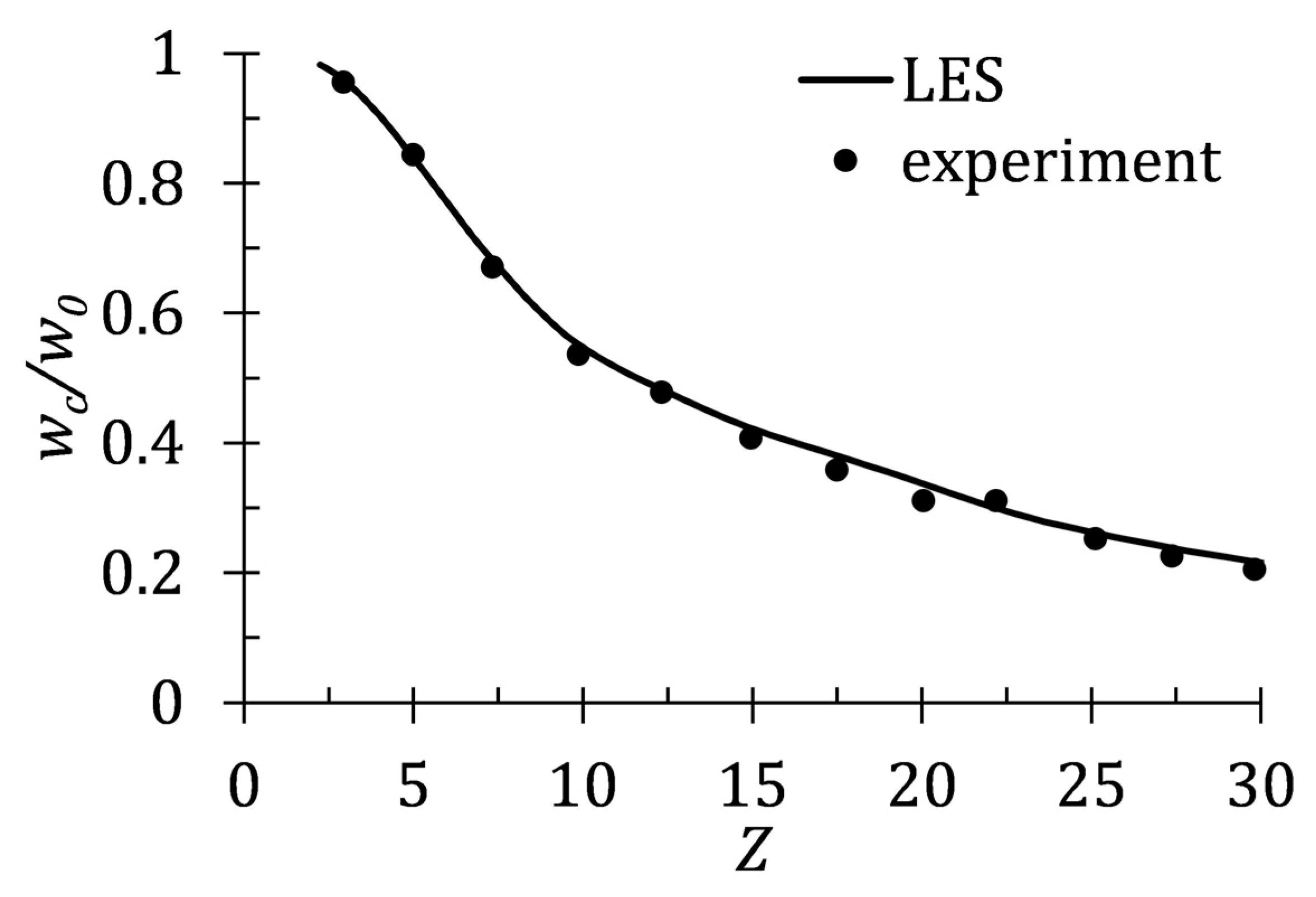
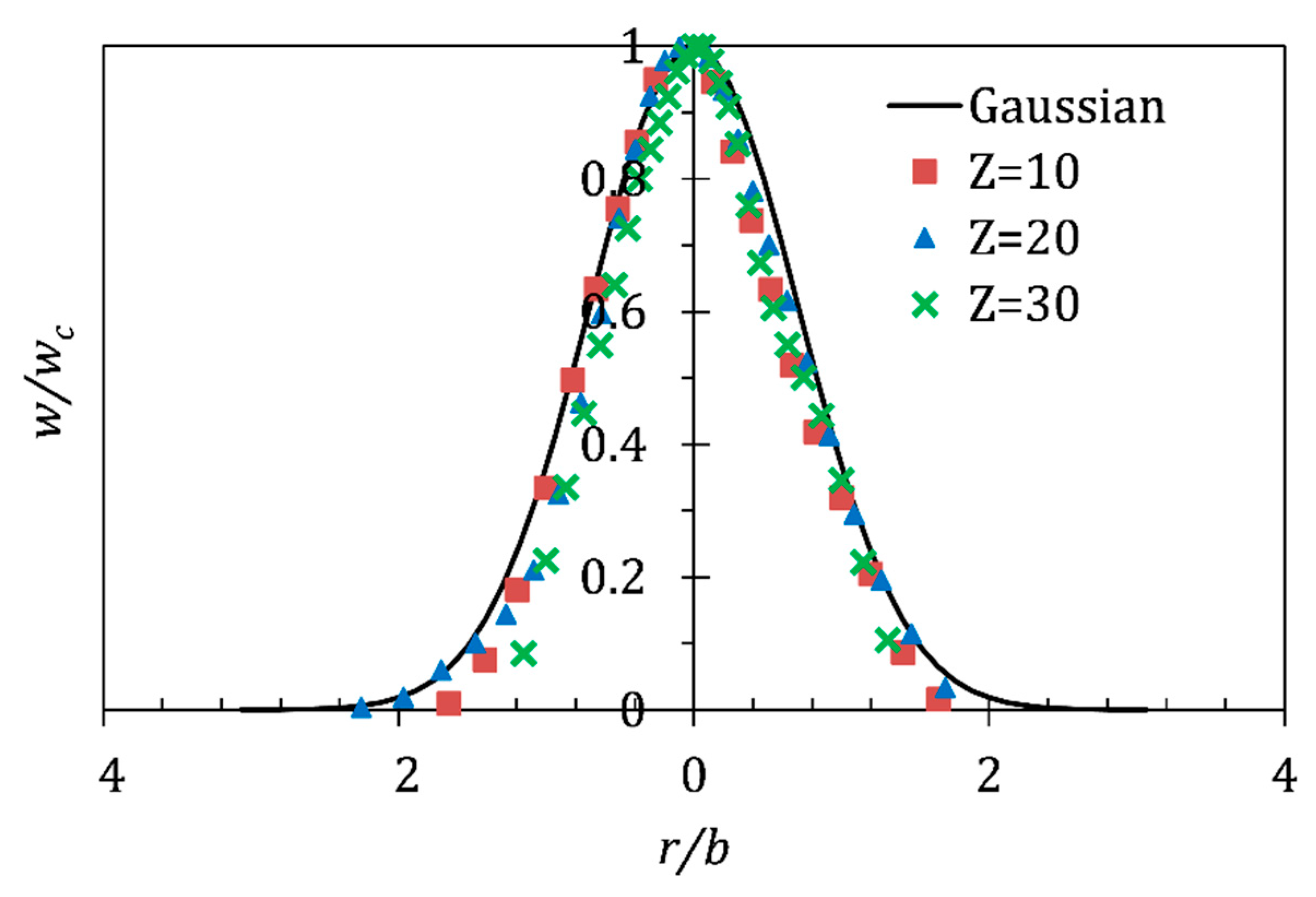
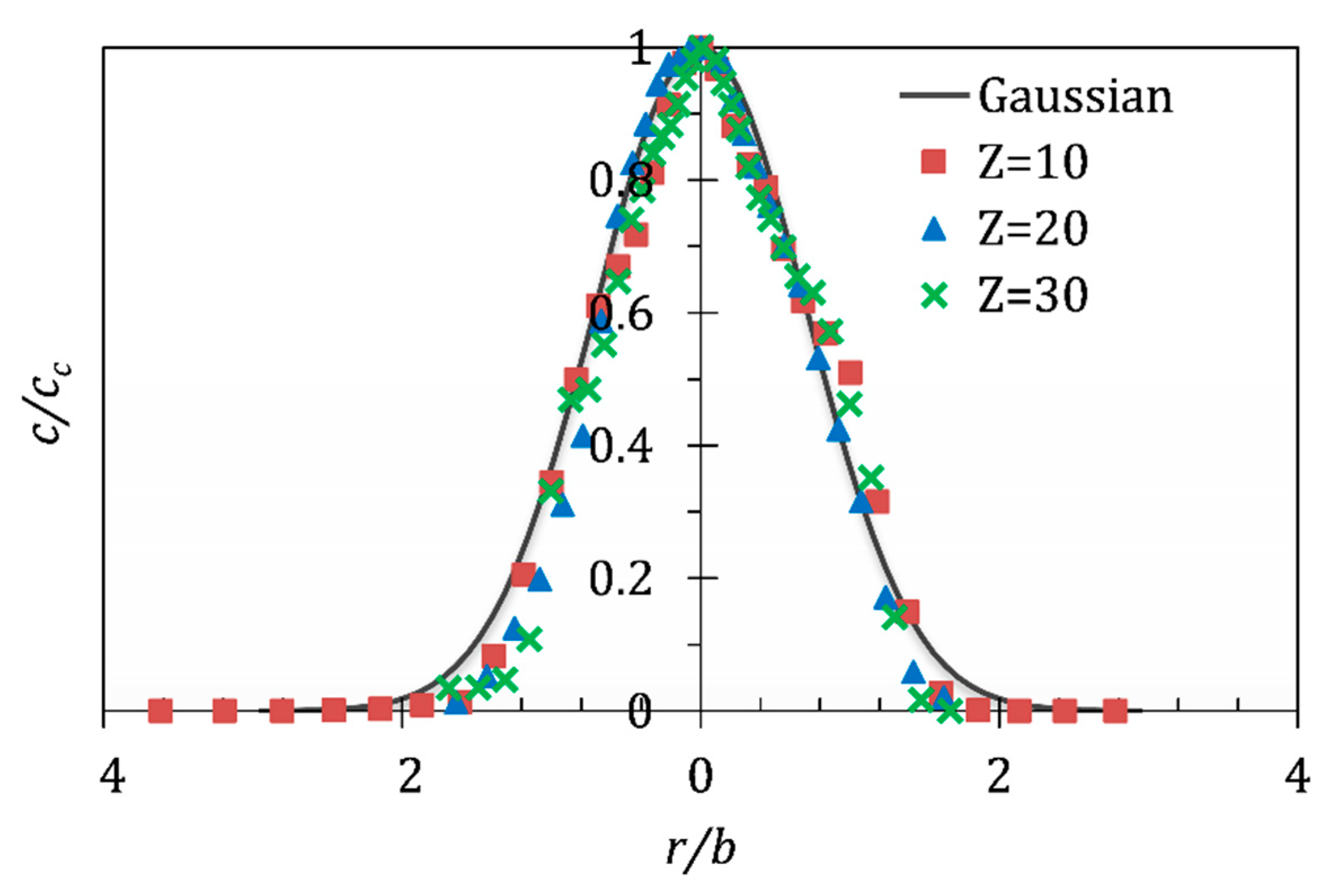
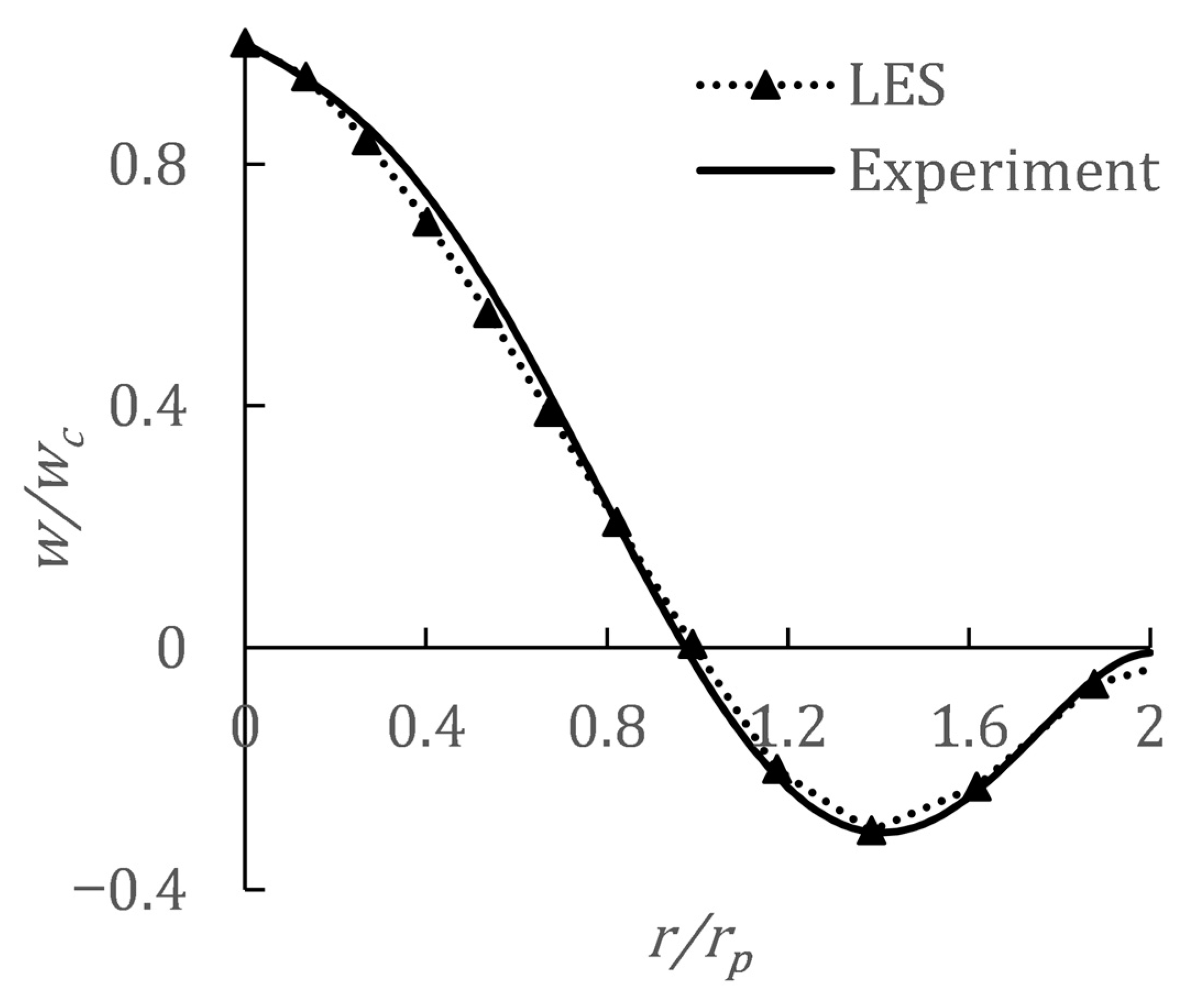
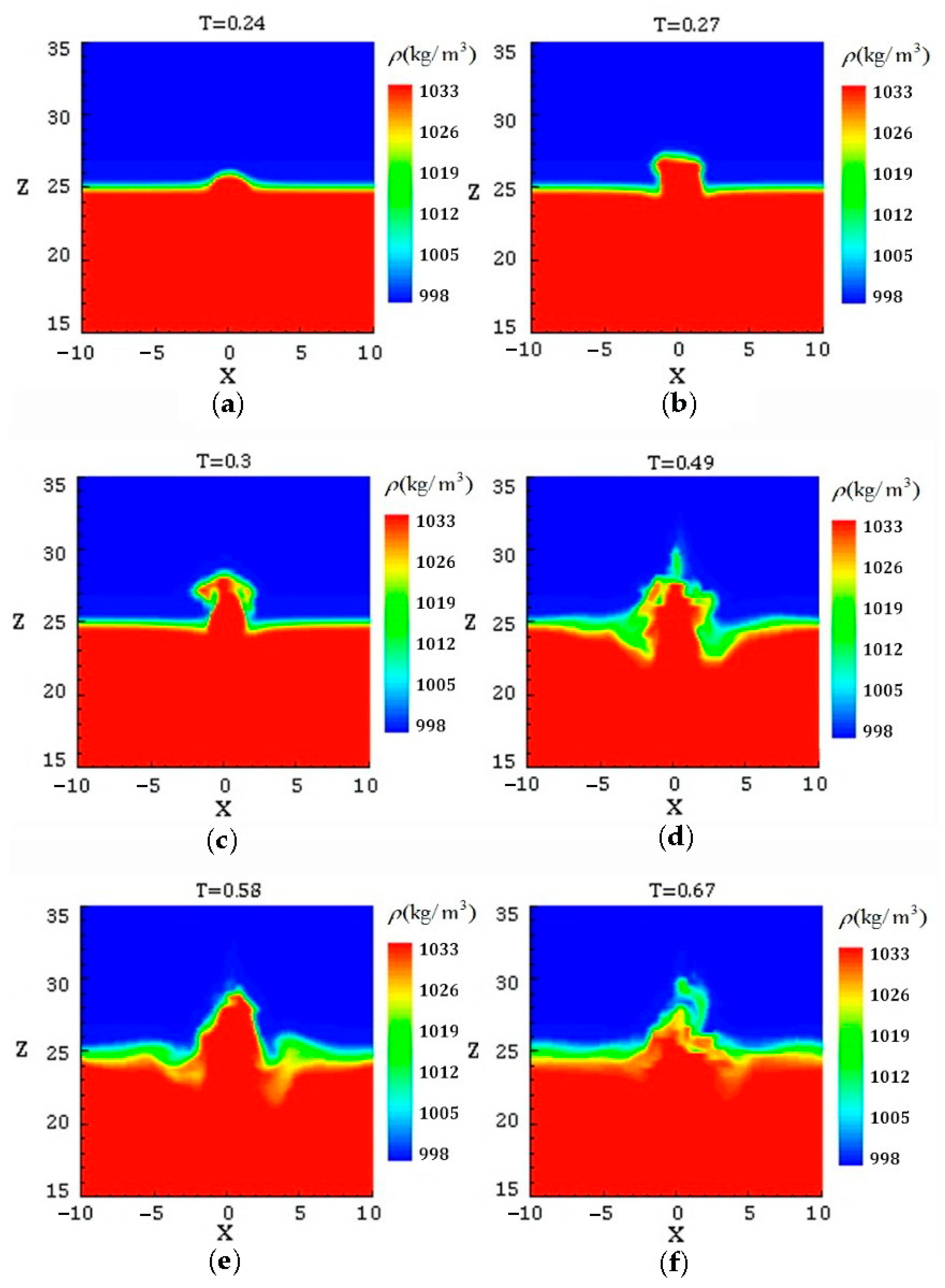
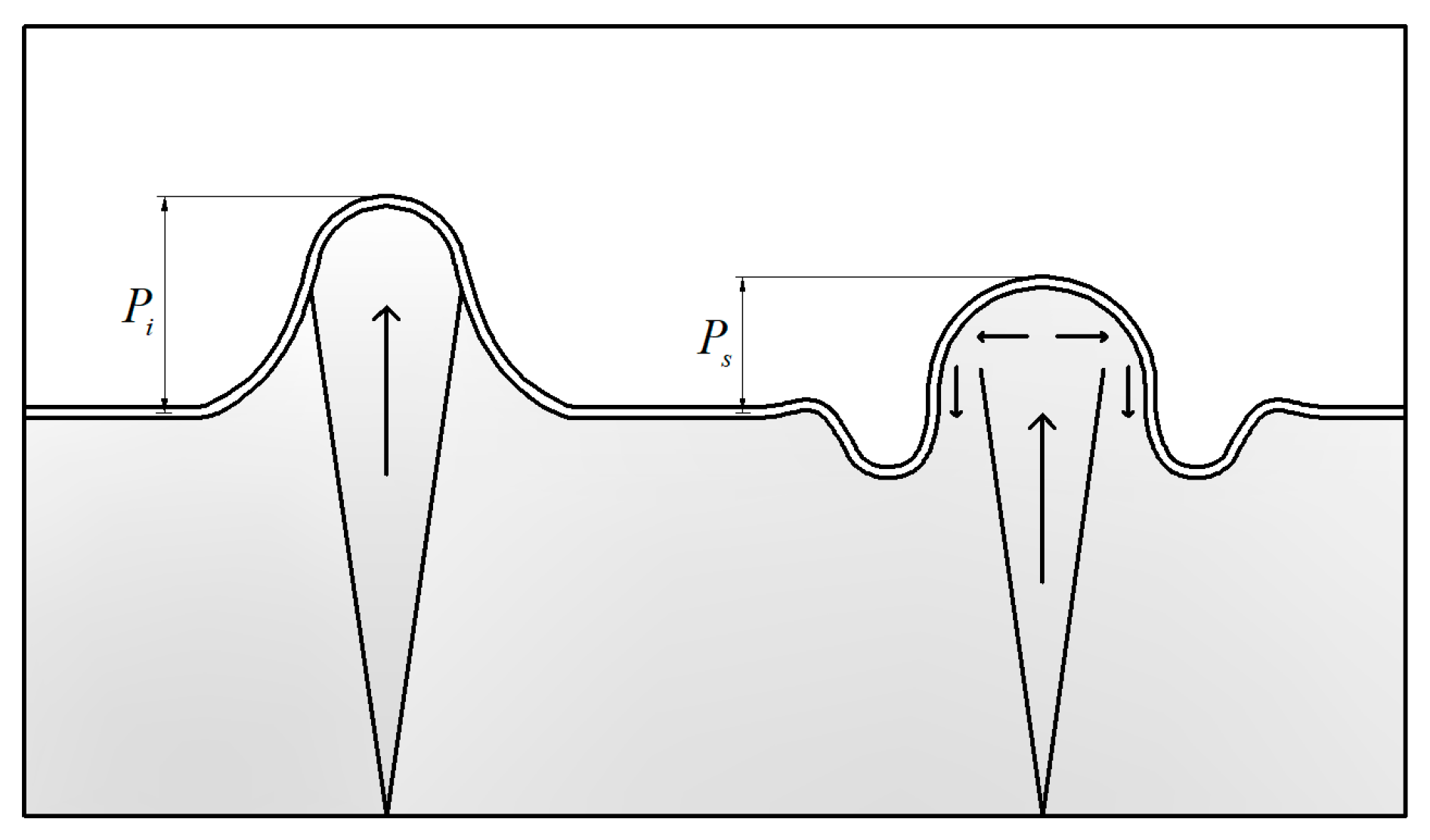
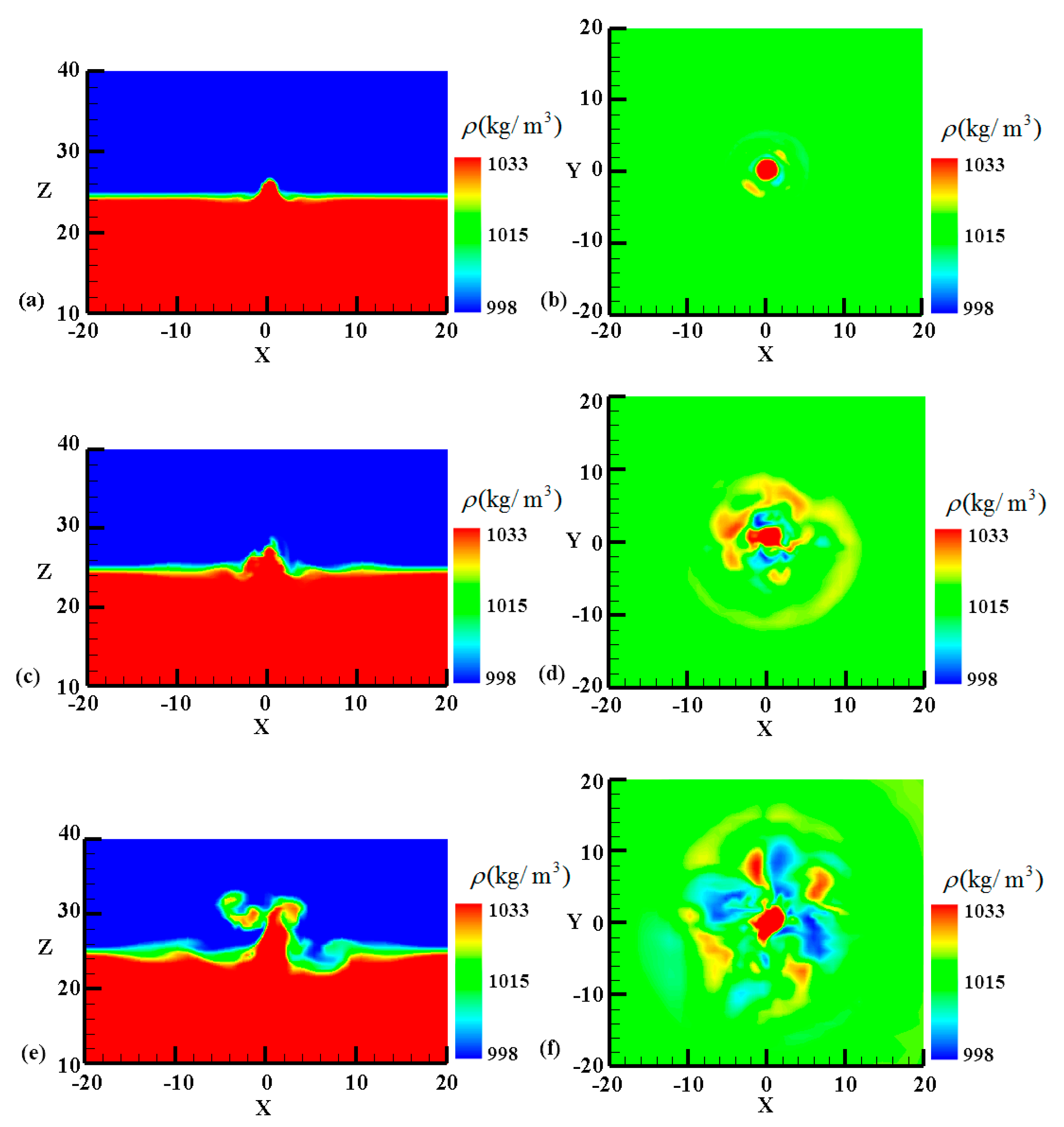
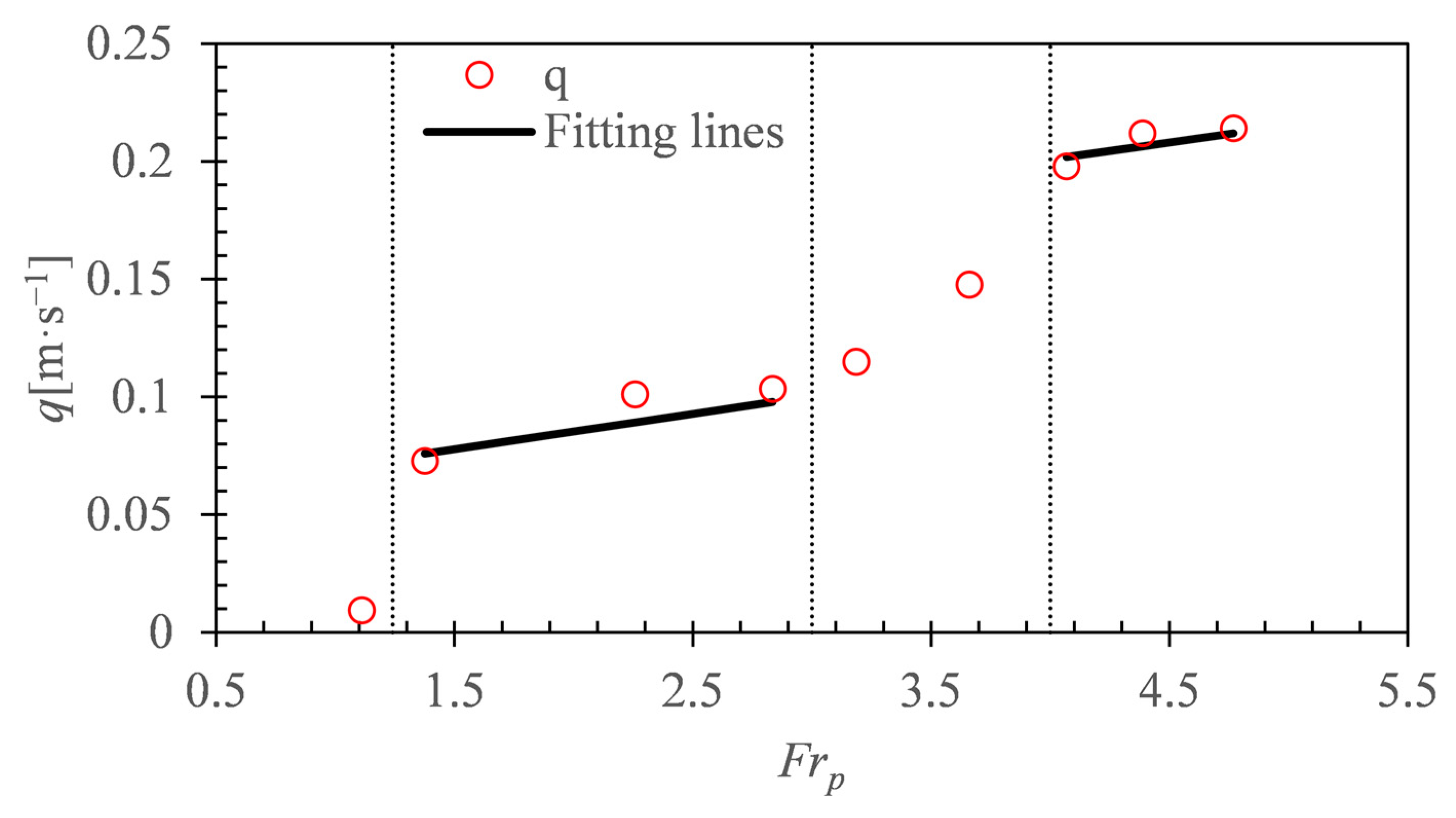

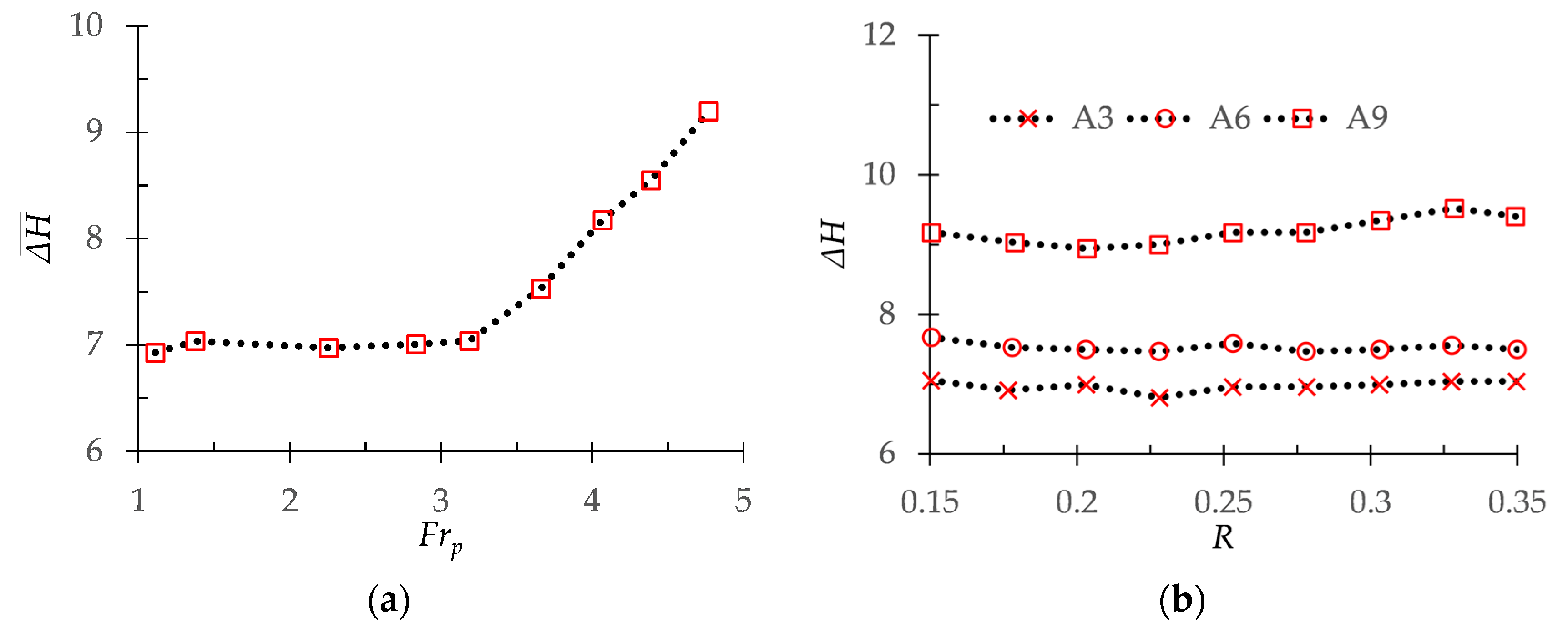
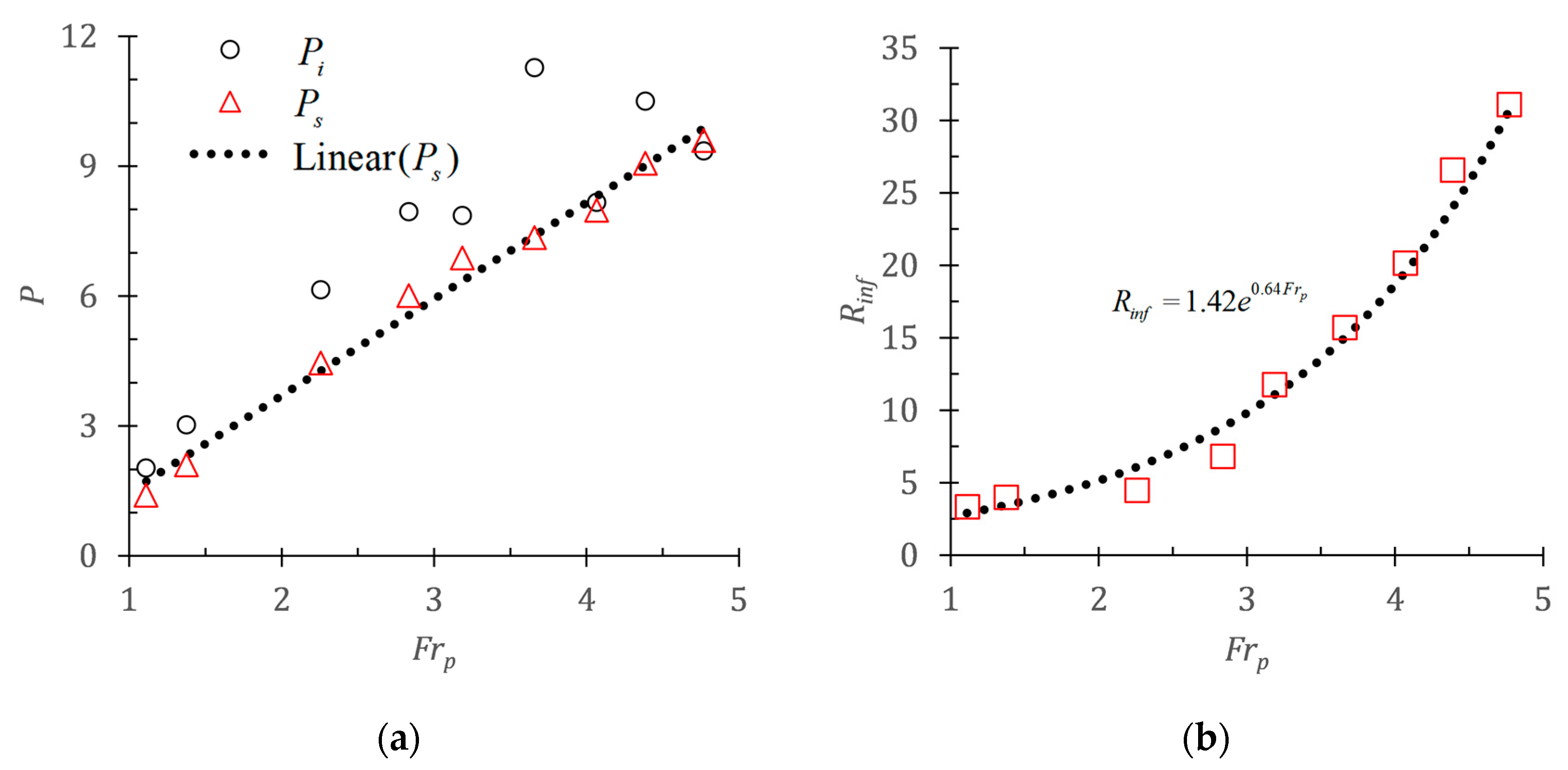
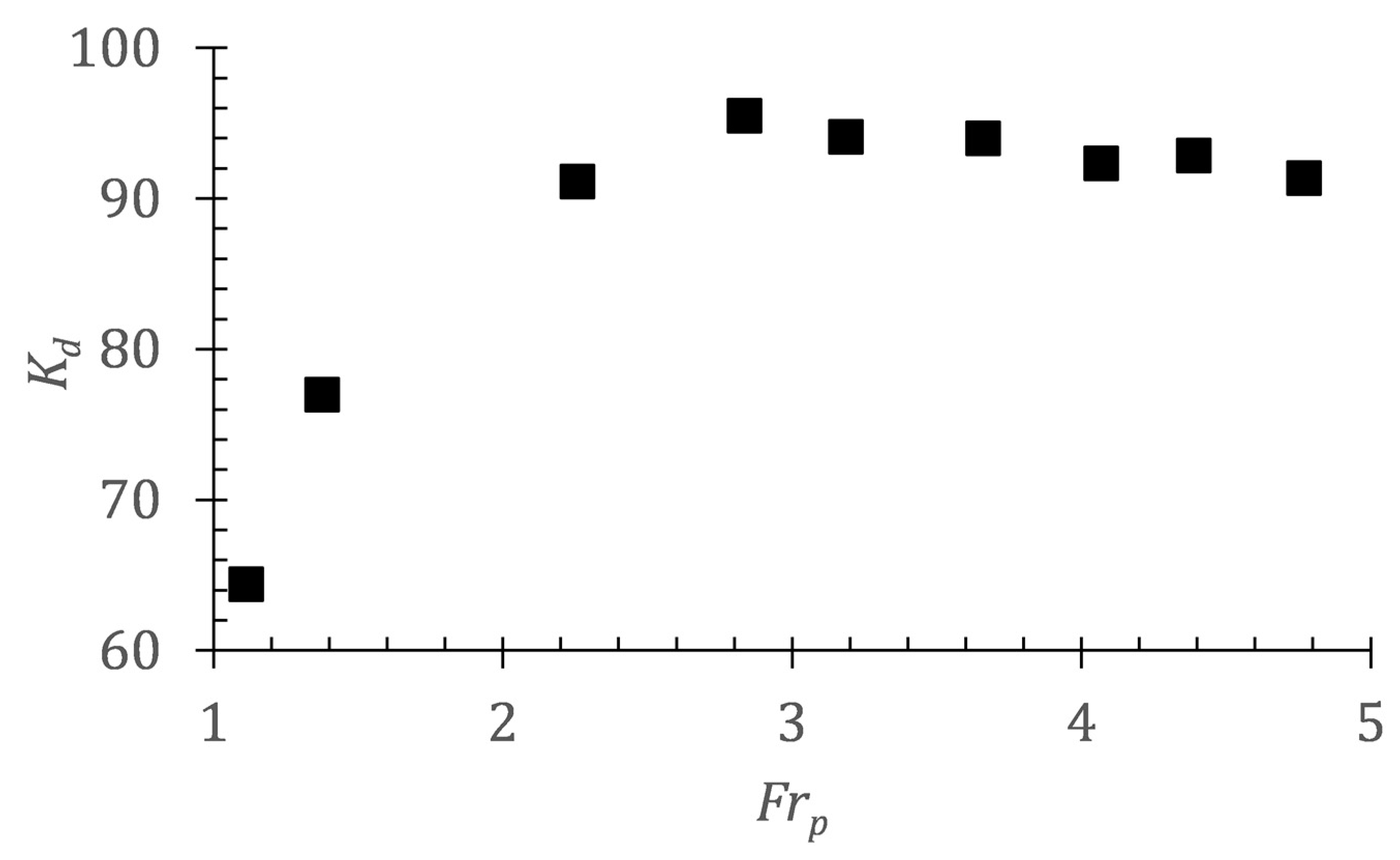

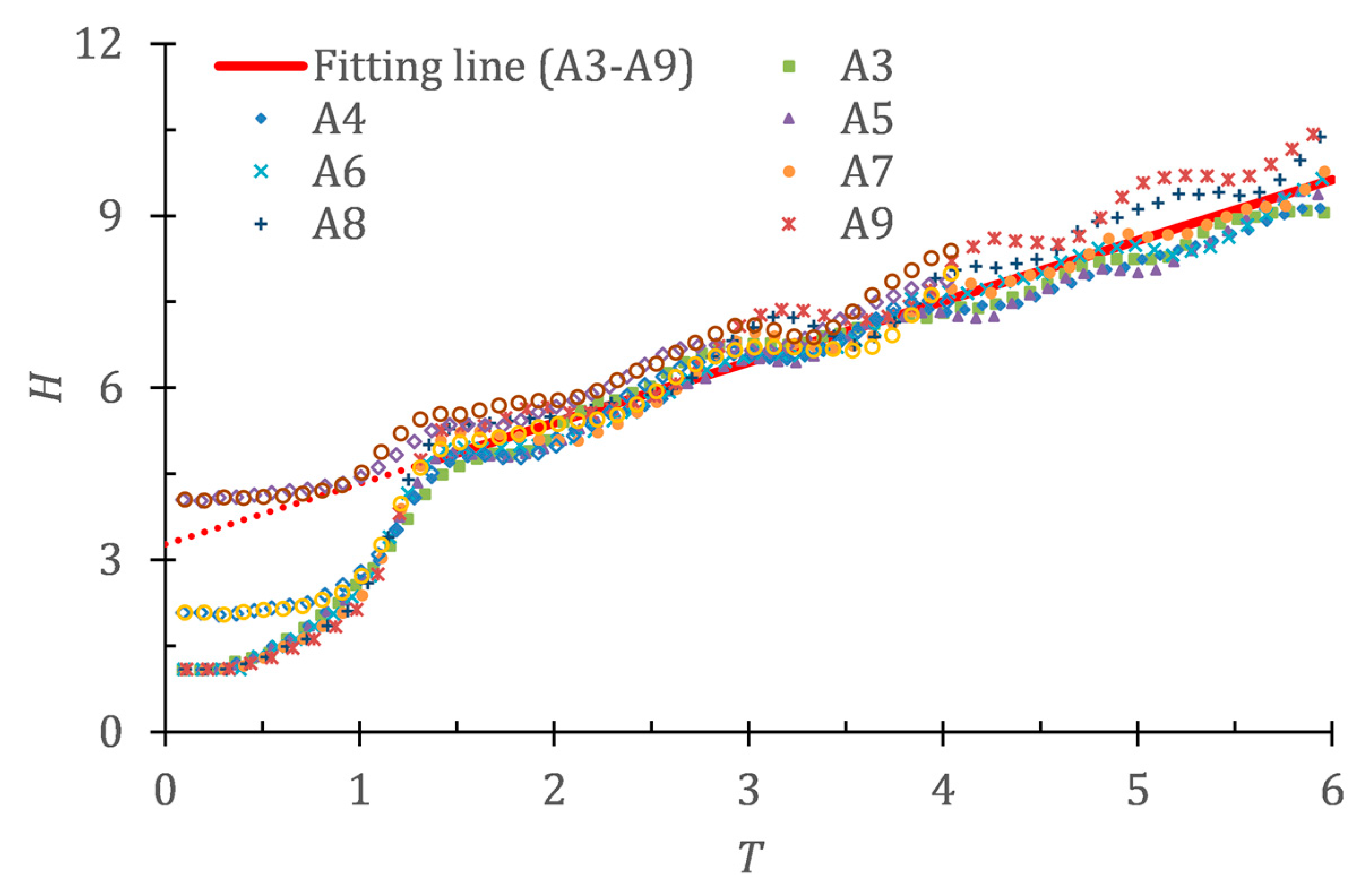
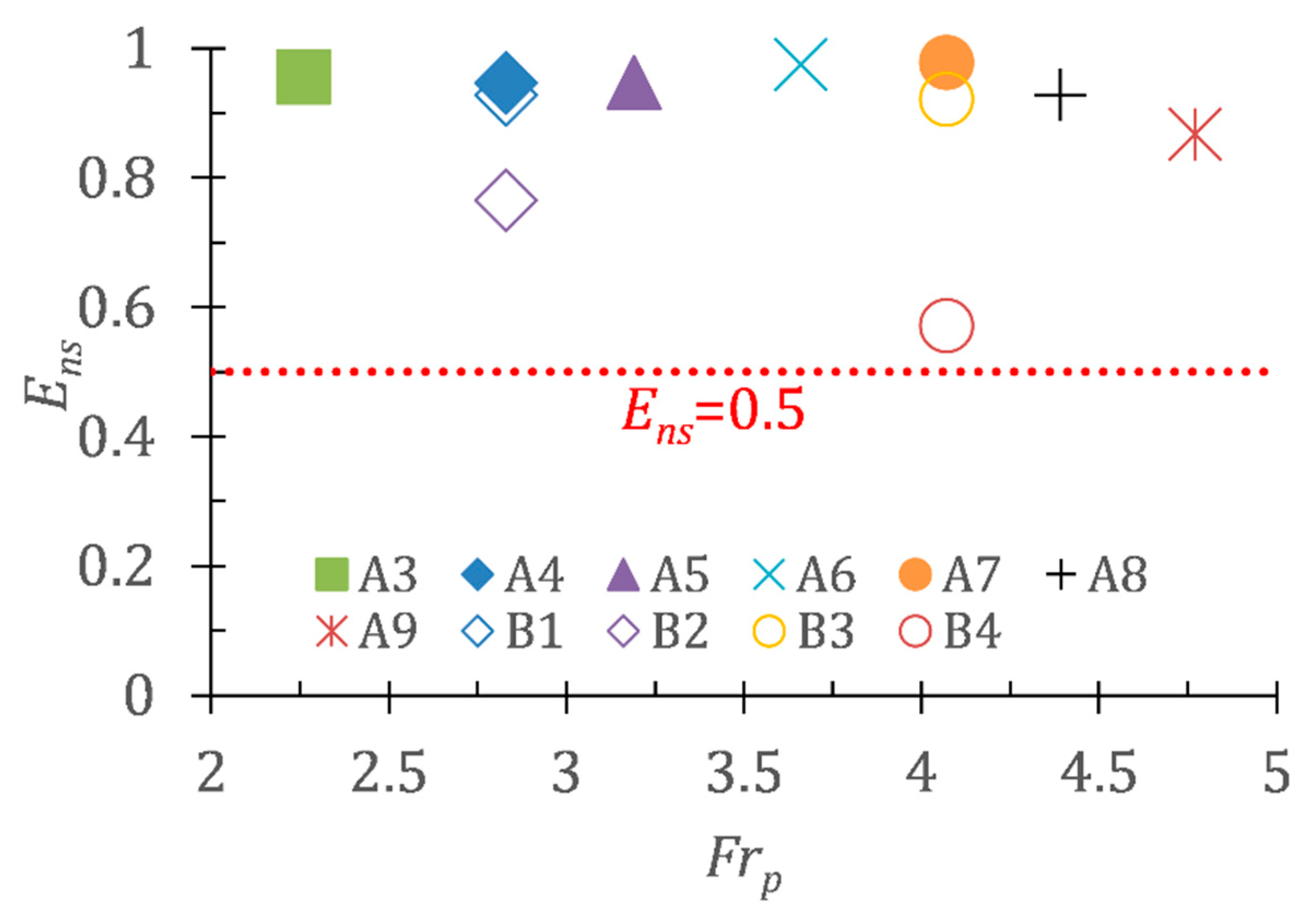
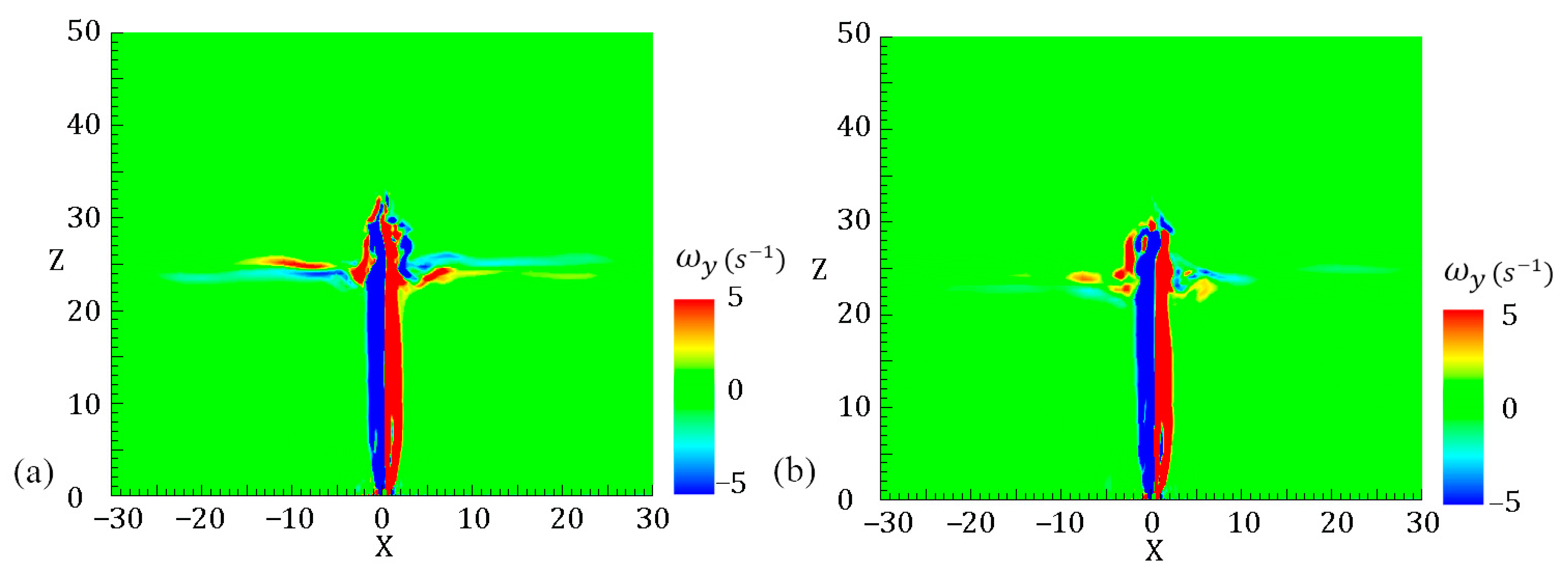
| Dimensionless Nozzle Size | Stratified/Unstratified | Experimental/Numerical | Fr0 | Re0 | Reference |
|---|---|---|---|---|---|
| 0.025 | Stratified | Numerical | 7~22 | - | Ezhova [17] |
| 0.01 | Stratified | Experimental | - | 896~1066 | Ansong [27] |
| 0.017 | Stratified | Experimental | - | 6900 and 12,400 | Cotel [22] |
| 0.0083 | Stratified | Experimental | 9–18.8 | 2979~5960 | Ahmad [3] |
| 0.0041~0.0088 | Unstratified | Experimental | 0.3~40 | 563~4037 | Burridge [16] |
| 0.033 | Stratified | Numerical | 1~9 | - | Druzhinin [18] |
| 0.0088 | Stratified | Numerical | 8.36~27.89 | 1760~8800 | This study |
| Cases | w0 | Fr0 | Re0 | Frp | Rep | H | ρu (kg/m3) | ρd (kg/m3) |
|---|---|---|---|---|---|---|---|---|
| A0 | 0.88 | 24.53 | 7744 | - | - | - | 998 | 998 |
| A1 | 0.2 | 5.58 | 1760 | 1.11 | 1393.07 | 1.0 | 998 | 1033 |
| A2 | 0.3 | 8.36 | 2640 | 1.37 | 1723.63 | 1.0 | 998 | 1033 |
| A3 | 0.4 | 11.16 | 3520 | 2.26 | 2828.66 | 1.0 | 998 | 1033 |
| A4 * | 0.5 | 13.94 | 4400 | 2.83 | 3553.58 | 1.0 | 998 | 1033 |
| A5 | 0.6 | 16.74 | 5280 | 3.19 | 3993.69 | 1.0 | 998 | 1033 |
| A6 | 0.7 | 19.52 | 6160 | 3.66 | 4588.04 | 1.0 | 998 | 1033 |
| A7 * | 0.8 | 22.31 | 7040 | 4.07 | 5099.32 | 1.0 | 998 | 1033 |
| A8 | 0.9 | 25.10 | 7920 | 4.39 | 5500.41 | 1.0 | 998 | 1033 |
| A9 | 1.0 | 27.89 | 8800 | 4.77 | 5979.11 | 1.0 | 998 | 1033 |
| B1 | 0.5 | 13.94 | 4400 | 2.83 | 3553.58 | 2.0 | 998 | 1033 |
| B2 | 0.5 | 13.94 | 4400 | 2.83 | 3553.58 | 4.0 | 998 | 1033 |
| B3 | 0.8 | 22.31 | 7040 | 4.07 | 5099.32 | 2.0 | 998 | 1033 |
| B4 | 0.8 | 22.31 | 7040 | 4.07 | 5099.32 | 4.0 | 998 | 1033 |
© 2020 by the authors. Licensee MDPI, Basel, Switzerland. This article is an open access article distributed under the terms and conditions of the Creative Commons Attribution (CC BY) license (http://creativecommons.org/licenses/by/4.0/).
Share and Cite
Huang, X.; Wang, L.-l.; Xu, J. Numerical Study on Dynamical Structures and the Destratification of Vertical Turbulent Jets in Stratified Environment. Water 2020, 12, 2085. https://doi.org/10.3390/w12082085
Huang X, Wang L-l, Xu J. Numerical Study on Dynamical Structures and the Destratification of Vertical Turbulent Jets in Stratified Environment. Water. 2020; 12(8):2085. https://doi.org/10.3390/w12082085
Chicago/Turabian StyleHuang, Xuan, Ling-ling Wang, and Jin Xu. 2020. "Numerical Study on Dynamical Structures and the Destratification of Vertical Turbulent Jets in Stratified Environment" Water 12, no. 8: 2085. https://doi.org/10.3390/w12082085




